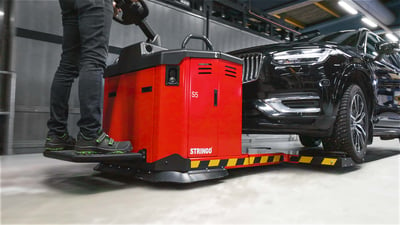As new challengers enter the automotive manufacturing industry, and traditional brands shift from ICE to EV production, how is this affecting daily operations on the factory floor and the production lines of automotive manufacturing? Discover the hottest trend and insights from two different markets with similar challenges, China and the US, as the automotive industry disrupts this fundamental aspect of manufacturing.
To find out how disruptive production lines are affecting today’s car manufacturers, we checked in with two experts from two different continents: Stringo Sales Director Susan Zhou in China and Steve Terrell, National Sales Specialist in the US who’ve been working with EV players laying out just the kinds of new production lines described.
Disruptive car brands don’t rely on assembly-line production
Classic assembly line production has been the trademark of the automotive industry for over a century. But the challengers entering the market today are making do without it. Steve Terrell from Stringo US explains it in almost in tech startup terms. “These startup companies are still young in their development process and aren’t producing mass volumes yet. As they scale up, they might move into premises with a large level floor space and a production line designed for the purpose. But for now, they’re manufacturing their vehicles in smaller facilities that aren’t optimised for automotive production.”
This affects how vehicles are transported between workstations during production, as well as how they’re moved in and out of the factories. “There’s an increasing need for equipment that lets staff move vehicles safely up and down sharper inclines than in a traditional factory. Especially since many of these companies are based in California where the landscape itself is very hilly”.
Chinese car manufacturers face similar challenges, although for slightly different reasons. “To protect factories from flooding during the rainy season, they’re often built higher up from the ground. This means you need to use ramps to get the vehicles in and out of the facilities,” says Susan Zhou from Stringo’s China team.
Another growing trend in China is that the lines between different industries are becoming increasingly blurry. Car companies like NIO and Geely are now developing their own smartphone models, while the mobile phone producer Xiaomi has ventured into electric car manufacturing. This seemingly unorthodox crossover highlights an ongoing shift where the car is becoming more of a tech product – not just a mode of transport.
New vehicle-moving challenges arise as traditional brands shift to EV production
New players aren’t the only ones changing how things are done. Most traditional car manufacturers have either already begun shifting their production from ICEs to EVs, or are about to do so. To stay profitable during the transition period, some of them set up temporary ‘popup’ factories where they keep production going while upgrading their main facilities. “These temporary production plants share similar challenges with the ones in the startup scene. The manufacturers don’t have the space and resources to create another traditional assembly line. Instead, they invest in tools that allow staff to easily move vehicles from one stage of the production process to the next,” says Terrell of this dynamic.
Car manufacturers will also find moving EVs in a plant is different from moving ICEs. “Electric cars tend to be heavier than combustion engine cars. There are also more situations where all four wheels of the car are inoperable, making it impossible to push the car by hand,” states Terrell.
In China, the shift to EVs has given rise to some unexpected partnerships.
“New companies moving into the automotive industry tend to focus only on EVs. Some of them will have a design team, clay modelers, and an R&D department, but no production plant of their own. Instead, they team up with a traditional car manufacturer who can produce the cars according to their plans,” explains Zhou.
Customised solutions that meet the changing needs of the market
As both established and up-and-coming manufacturers are adapting to a rapidly changing market, Stringo’s vehicle movers are utilised in slightly different ways.
“In an old-school manufacturing plant, the main job of a Stringo is to quickly get non-starters off the line. In a non-traditional factory, our machines become an integrated part of the production process, as it’s used to move the vehicle between different pods or workstations,” states Terrell. And New types of environments often require customised solutions according to Zhou.
“Every company has different conditions that we need to take into consideration, from the weight of the cars and the size of the wheels to obstacles and ramps at the facilities. For example, one customer produced a car model with particularly low ground clearance. To meet their needs, we made the wheels of the Stringo smaller.”
It’s not unusual for custom machines to end up as part of Stringo’s standard product range.
“If an industry frontrunner is experiencing a challenge, chances are more companies will run into the same issues later on. The Stringo DuoMover, which is a flexible four-wheel-moving solution originally created for one particular customer, is an excellent example. Our engineers have also developed new powerful models to accommodate the growing demand for moving cars on slopes,” explains Terrell as he considers the ability to adapt to market demands, while also focusing on long-term quality, as the main strength of Stringo. “There’s a fine balance between being agile enough to adapt to a changing market, while also taking the time to do things properly. That’s exactly what we do at Stringo. We pride ourselves on creating solutions that will serve our customers well for many years.”
Want to know more about how Stringo helps car manufacturers ensure safe and efficient vehicle moving in difficult circumstances? Don’t miss our case study article about a challenging environment that called for creative solutions.





